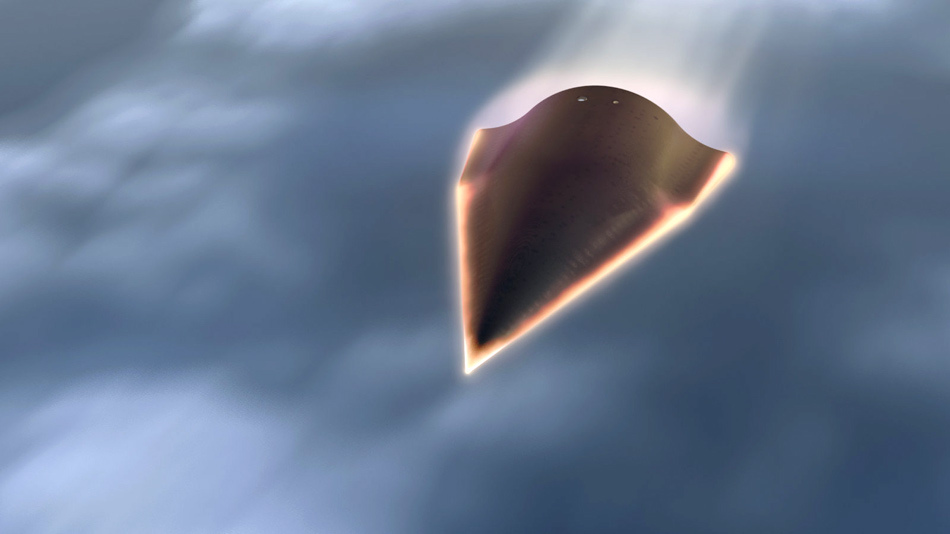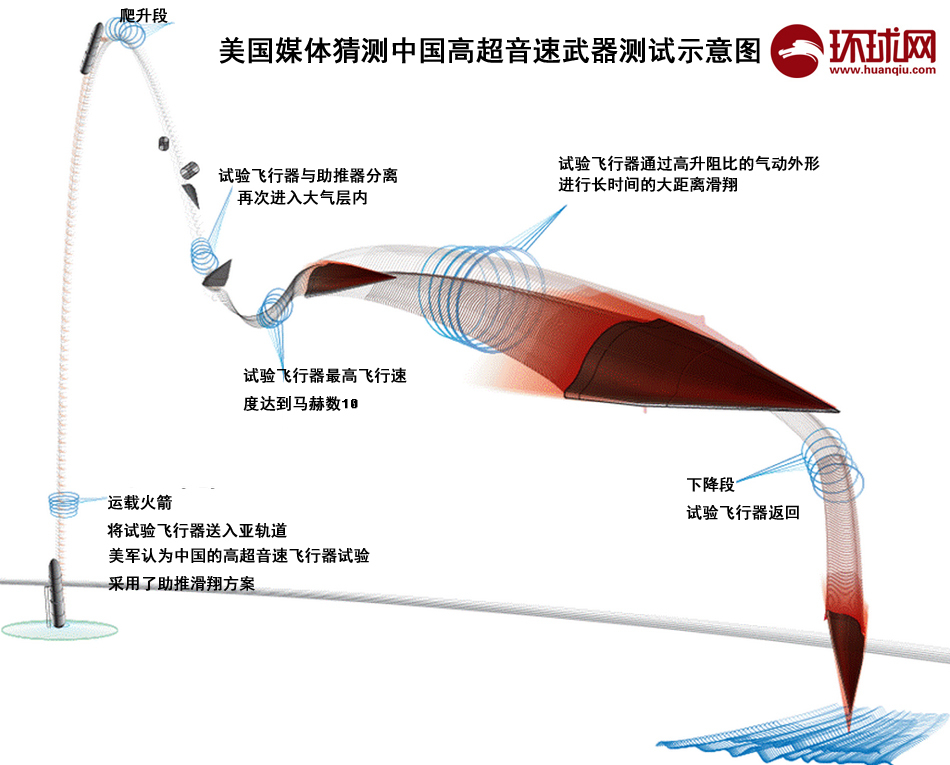

美国国防部官员称,中国军方上周进行了新型高超音速飞行器的首次试飞,高超音速飞行器的目的是突破美国导弹防御,向美投射导弹弹头。
不愿意透露姓名的官员称,这种新型高 超音速滑翔飞行器的实验是在1月9日进 行的。五角大楼已将中国的这一实验性武器取名为WU-14。
高超音速飞行器是中国神秘的战略核力量及常规军事和导弹项目向前迈出的重要一步
就中方实验进行讨论的官员们称,美国 探测到中国新型高超音速飞行器在中国 上空的飞行测试时以非常高的速度飞行 。官员们称,高超音速飞行器看起来是被设计安装在中国洲际弹道导弹之上, 随后在近太空以10倍音速滑翔和机动飞向目标。
国防部的一位发言人证实了中方实验, 但拒绝提供细节。国防部发言人、美国 海军陆战队中校杰弗里-普尔对《华盛顿自由灯塔》称:“我们对外国防务活动 进行了例行的监控,我们获悉了此次实 验的情况。不过,我们不会就我们所获得的外国武器系统的情报或者评估发表评论。我们鼓励中国就其防务投资和目标采取更透明立场,以避免误判。”
美国、俄罗斯、中国都参加了高超音速武器竞赛。它们都在研发高速航天飞行器。印度也在研发其布拉莫斯巡航导弹的高超音速版。
高超音速武器使用了先进技术,以便在太空和空气中以超高速飞行和机动。未来的武器将包括有动力和无动力的高超音速飞行器,它们将从洲际弹道导弹、 潜水艇发射导弹的最后一级发射,也可以从战略轰炸机的弹舱发射。各国预计 还将研发高超音速巡航导弹和监视无人机。
高超音速飞行器的军事优势包括精确目 标打击、非常快速的武器投送、对导弹和航天防御的高生存性。
高超音速的速度在时速6179公里至12359 公里,即在马赫5至马赫10之间。
中国军事事务专家称,高超音速飞行器实验是一个重要的里程碑,看起来是中国发展不对称战争武器的一部分。中国 将不对称战争武器称之为“杀手锏”武 器-这种高技术将帮助中国总体上处于较弱的军事力量击败在技术上要更为先进的美国军队。
美国前空军军官、中国战略武器系统专家马克-史托克斯称,中国正在着手研发两个超高音速飞行器项目,它们都是远程战略武器。上周的测试看起来是一个新型的加力后飞行器,它被设计用导弹发射。
中国也正研发一种高超音速、由超音速燃烧冲压发动机提供动力的飞行器,它可以独立发射,也可由轰炸机发射。
史托克斯称,高超音速滑翔飞行器可能 是在火箭的初步推进阶段后用导弹发射的,高超音速滑翔飞行器随后在近太空(距地球不到99公里)的地方向目标飞 去。史托克斯说:“理论上说,助推-滑 翔导弹是为了对付现存的中段导弹防御 。中国的技术研究已表明,飞行器可以 为其高空打击目标使用可穿透性雷达。
史托克斯称,高超音速飞行器是中国航 天武器的一部分,航天武器的设计目标 是将经过太空的弹道导弹和紧贴地面的 巡航导弹的特点结合在一起。史托克斯 说:“就作战和工业角度来说,高超音 速航天飞行器是航空和航天领域融合的 榜样。”
身为华盛顿“2409项目研究所”分析师的史托克斯称,中国军方报告指出,其 高超音速滑翔飞行器将从太空边缘以马赫8至马赫12的速度飞行,也就是以时速9791公里至14688公里。
这样的速度将对美国目前的导弹防御系统形成挑战。美国目前的导弹防御系统 包括远程拦截导弹、中程海基和陆基拦 截导弹、在更接近目标的地方拦截来袭 导弹的拦截导弹。
卡内基国际和平基金会研究员、中国战略系统专家罗拉-萨尔曼称,中国的高超音速武器是中国研发精确制导导弹和其它先进武器能力项目的一部分。
曾在中国花了多年时间研究中国军事和 其它书面材料的萨尔曼称,有关中国高 超音速武器的书面材料显示,中国可能 寻求高速武器,其射程更有限,将装备常规弹头,虽然也可能装备战略核弹头。
美国全球快速打击项目寻求研发能够在 一小时内打击地球上任何地点的高超音速、其它常规和核武器。美国这一系统 的组成部分预计将在未来10年至15年部署到位。
萨尔曼称,中国的高超音速实力看起来是诸如DF-21D反舰弹道导弹等精确打击导弹和中国自己版本的导弹防御系统(使用高速动能杀伤方式)的副产物。萨 尔曼在一份电子邮件上称:“在将战略 分析和规划和技术研究结合后,中国发 展高超音速和高精确武器的速度有可能 比其先前的反卫星和反弹道导弹防御的 速度更快,也要更为专注。最近的实验 表明了这一趋势。她在最近的一篇讲演中称,就中国军事的发展而言,高超音速和精确制导在中国是增长领域。
另一位中国军事事务专家、国际评估和 战略中心的分析师里克-费舍尔称,中国 高超音速滑翔飞行器测试是中国取得的 一项重大军事进展。他说:“高超音速 滑翔飞行器的优势在于它可以执行高超 音速精确打击,同时保持相对低的高度 、平滑的弹道,使其更加不易被导弹防 御系统拦截。”
费舍尔称,支持军备控制的人士经常认 为美国的全球快速打击项目和类似的中 国高超音速武器是孤立的竞争,这是因 为他们错误地认为这种竞争能通过军备 会谈而得到解决。他说:“我不反对会谈,但是最近历史的教训是相当明确的 :不管你试图多么地友好地对待它,一个偏执狂的独裁政权将试图寻求最大规模的力量来维持其地位。”
费舍尔称,中国除了高超音速武器和其 它与美国全球快速打击项目类似的武器之外,中国还在建设其支持其全球实力 投射的战略军事实力。他说,中国人正 在积极寻求全球军事实力以挑战美国, 它到目前为止没有会谈或者参与军控的 兴趣。费舍尔认为,美国不应试图与中 国进行军事和其它热线沟通渠道,美国 政府应当有选择地建设军事优势力量, 以便威慑中国至2020年及以后。他说: ”我不认为本届政府认识到这一真正的挑战。“美国国防部有关中国军力的最新报告称,中国2012年5月建成了一个新的JF12高超音速风洞,它是世界同类型中的最大 风洞,可以模拟马赫5至马赫9之间的飞行条件。
2012年12月发布的一份中国技术文件披露称,中国计划使用机载精确制导系统,可以使用卫星和天文导航进行飞行阶段纠正。
4月份的第二篇文章得出结论称,高超音 速武器构成了新的航天威胁。它披露称 ,中国已研究了美国空军实验型X-37B空 天飞机,以便有效地跟踪和拦截高超音 速飞行器。文章称:“在航空航天的高 超音速飞行器通常有以下特点:高度高 、速度快、积极小。它们的动能非常多变。因此,这种类型的目标很难跟踪。 ”
美国和俄罗斯也在研发高超音速武器
美国目前的高超音速研究由国防部和空 军通过“从美国大陆发射的应用性武装 ”项目实施。美国已对数个飞行器进行 了研究,其中包括洛克西德的HTV-2(高 超音速技术飞行器),它是一种无人、 用导弹发射的可机动飞行器,可以最高速度马赫20滑向地球。
波音公司也在研发X-51乘波者,它是一种由飞机发射的、装备超燃冲压发动机的飞行器,被设计用来进行高超音速攻 击、侦察和商业运输。
另一个飞行器是美国空军实验型X-37B空天飞机,它自2012年12月就一直绕地球轨道飞行。
俄罗斯也在高超音速武器方面取得进展,其中包括攻击型高速攻击和针对高速 音速打击防御的技术。
美国空军的国家航空和航天情报中心在 其去年的导弹年度报告中称,俄罗斯正在建设新一级的高超音速飞行器,这将 使俄罗斯战略导弹能够突破导弹防御系统。
俄罗斯第一副总理米特里-罗戈津最近将 高速音速武器的发展与上世纪五十年代原子弹武器的出现相提并论。他称,首个掌握高超音速武器的国家将发起军事事务的新革命。
罗戈津去年六月份否认俄罗斯在与美国进行新的军备竞赛。不过,他证实,俄罗斯正在研发高超音速武器。他6月23日 在俄罗斯电视台上称:“我们今天正在 经历军事科学的一场革命。革命与高精 确的大规模毁灭技术的快速发展相关。 它们是巡航导弹和高速火箭武器。未来 将出现高超音速武器。”
罗戈津将俄罗斯实验RS-26先进公路机动 洲际导弹形容为是“导弹防御杀手”。 俄罗斯新闻报道称,导弹飞行实验涉及旨在击败导弹防御系统的三个高超音速假弹头。
俄罗斯军事专家已撰文提出将高超音速 与精确导航结合在一起。一些人提议将美国的高超音速武器列入未来的军备控 制会谈。莫斯科先前也曾利用武器协议 来限制美国的高技术武器。
俄罗斯还在研发被称作S-500的空天防御系统,这种系统具备击落高超音速飞行器的能力。
2049项目研究所的研究员伊斯顿在一份 报告中称,中国的高超音速武器是他所称的“太空伟大游戏”的一部分。他说 :“如果本世纪发生大国战争的话,战 争将不会始于地面和空中的爆炸声,而将是始于外太空的动能和激光光束的无 声启动。”
China Conducts First Test of New Ultra-High Speed Missile Vehicle
Test is part of a new arms race for super fast weaponry
BY: Bill Gertz Follow @BillGertz
January 13, 2014 4:59 am
China’s military last week conducted the first flight test of a new ultra-high speed missile vehicle aimed at delivering warheads through U.S. missile defenses, Pentagon officials said.
The test of the new hypersonic glide vehicle was carried out Jan. 9 and the experimental weapon is being dubbed the WU-14 by the Pentagon, said officials who spoke on condition of anonymity.
The hypersonic vehicle represents a major step forward in China’s secretive strategic nuclear and conventional military and missile programs.
The new hypersonic vehicle was detected traveling at extremely high speeds during the flight test over China, said officials who discussed some details of the test.
The hypersonic craft appears designed to be launched atop one of China’s intercontinental ballistic missiles, and then glides and maneuvers at speeds of up to 10 times the speed of sound from near space en route to its target, the officials said.
A Pentagon spokesman confirmed the test but declined to provide details.
“We routinely monitor foreign defense activities and we are aware of this test,” Marine Corps Lt. Col. Jeffrey Pool, the spokesman, told the Washington Free Beacon.
“However, we don’t comment on our intelligence or assessments of foreign weapon systems,” Pool said in a statement. “We encourage greater transparency [by the People’s Republic of China] regarding their defense investments and objectives to avoid miscalculation,” he added.
The United States, Russia, and China are all engaged in a hypersonic arms race. All three nations are developing high-speed aerospace vehicles. India is also developing a hypersonic variant of its BrahMos cruise missile.
Hypersonic weapons use cutting edge technology for flying and maneuvering at ultra-high speeds in space and air. Future weapons will include powered and unpowered hypersonic vehicles fired from the last stages of ICBMs and submarine missiles, and from the bomb-bays of strategic bombers. Hypersonic cruise missiles and surveillance drones also are expected.
The military advantages of hypersonic craft include precise targeting, very rapid delivery of weapons, and greater survivability against missile and space defenses.
Hypersonic speed is between 3,840 miles per hour and 7,680 miles per hour, also known as Mach 5 to Mach 10.
China military affairs specialists said the hypersonic vehicle test is a significant milestone and appears to be part of China’s development of asymmetric warfare weaponry that Beijing calls “assassin’s mace” weapons—high-technology arms that would assist China’s overall weaker military forces to defeat the more technologically advanced U.S. military.
Mark Stokes, a former U.S. Air Force officer and specialist on China’s strategic weapons systems, said China is working on two hypersonic flight vehicle programs that are long-range strategic arms. Last week’s test appears to be a new post-boost vehicle designed to launch from a missile.
China is also developing a hypersonic, scramjet-powered vehicle that can take off independently or be launched from a bomber.
The hypersonic glide vehicle is likely missile-launched after the rocket’s initial boost phase that then takes off toward its target from near space, or less than 62 miles from earth, Stokes said.
“A boost glide missile theoretically would be intended to counter existing mid-course missile defenses,” he said, noting that Chinese technical studies have shown the vehicle would use penetrating radar for its high-altitude targeting.
The vehicle is part of China’s aerospace weaponry designed to blend the characteristics of space-transiting ballistic missiles with ground-hugging cruise missiles, Stokes said.
“Hypersonic aerospace flight vehicles exemplify the merging of the air and space domains from both operational and industrial perspectives,” Stokes said.
Stokes, an analyst with the Project 2049 Institute, said Chinese military reports indicate that its hypersonic glide vehicles will travel from the edge of space at speeds ranging between Mach 8 and Mach 12, or between 6,084 miles per hour and 9,127 miles per hour.
Such speeds would challenge the current system of U.S. missile defenses. Those defenses include a combination of long-range interceptors, medium-range sea and land-based interceptors, and interceptors designed to hit incoming missiles closer to targets.
Lora Saalman, a specialist on Chinese strategic systems with the Carnegie Endowment, said China’s hypersonic arms are part of a program to develop precision-guided missiles and other advanced weapons capabilities.
Saalman, who spent years in China studying Chinese military and other writings, said writings on Chinese hypersonic arms indicate Beijing may be seeking high-speed weapons that are more limited in range and conventionally armed, although with strategic nuclear potential.
The U.S. Prompt Global Strike program seeks hypersonic and other conventional and nuclear weapons capable of attacking any location on earth within an hour. Elements of the U.S. system are expected to be fielded in the next 10 to 15 years.
China’s hypersonic capabilities also appear to be an outgrowth of precision strike missiles, like the DF-21D anti-ship ballistic missile, and China’s own version of missile defenses, which use high-speed hit-to-kill capabilities, Saalman said, noting that China has been streamlining its weapons development process.
“With the integration of strategic analysis and planning into technical research, China’s pursuit of hypersonic and high-precision weaponry promises to be faster and more focused than that associated with its previous [anti-satellite] and [ballistic missile defense] related research and programs,” Saalman said in an email. “This recent test is a manifestation of this trend.”
Hypersonics and precision guidance “are growth areas within China in terms of what they are intending to do with their military,” she said in a recent speech.
Rick Fisher, another China military affairs expert, said the Chinese hypersonic glide vehicle (HGV) test represents a significant military advance for Beijing.
“The beauty of the HGV is that it can perform hypersonic precision strikes while maintaining a relatively low altitude and flat trajectory, making it far less vulnerable to missile defenses,” said Fisher, an analyst at the International Assessment and Strategy Center.
Fisher said arms control advocates often view the U.S. Prompt Global Strike and similar Chinese hypersonic weapons as part of an isolated competition caused by misperceptions that can be resolved through arms talks.
“I’m not against that, but the lessons of recent history are pretty stark: a paranoid Communist dictatorship is going to seek maximum power to sustain its position no matter how friendly you try to treat it,” Fisher said.
Fisher said that in addition to China’s hypersonic weapons and other weaponry similar to the arms in the U.S. Prompt Global Strike program, China is also building its strategic military capabilities to support its global power projection.
The Chinese are “actively seeking global military power to challenge the United States, and it is not yet in any mood to talk, or engage in arms control, about it,” he said.
Instead of seeking military and other hot line communications, the U.S. government should build on select military superiorities in order to deter China into the 2020s and beyond, Fisher said. “I don’t see this administration being seized with this real challenge,” he added.
The Pentagon’s most recent annual report on the Chinese military said that in May 2012 China opened a new JF12 shockwave hypersonic wind tunnel—the largest of its kind in the world—that replicates flying conditions between Mach 5 and Mach 9.
A Chinese technical paper from December 2012 revealed that China plans to use on-board precision guidance systems that would be corrected in-flight using both satellite and celestial navigation.
A second paper from April concluded that hypersonic weapons pose “a new aerospace threat.” It reveals that China has studied the U.S. Air Force’s experimental X-37B Space Plane in order to “effectively track and intercept” hypersonic vehicles.
“Hypersonic aircraft in aerospace usually have the following unique characteristics: high, fast, and small,” the paper states. “Their motion is highly variable. As a result, this type of target is very difficult to track.”
Both the United States and Russia are also developing hypersonic weapons.
Current U.S. hypersonic research is being carried out by the Pentagon and Air Force through the Force Application and Launch from Continental United States, known as the FALCON program.
Several vehicles are being studied, including the Lockheed HTV-2 or Hypersonic Technology Vehicle, an unmanned, missile-launched maneuverable aircraft that glides to earth at speeds up to Mach 20, or 13,000 miles per hour.
Boeing is also working on the X-51 WaveRider, an aircraft-launched, scramjet-powered vehicle that is being designed for hypersonic attack, reconnaissance, and commercial transport.
The U.S. Hypersonic Technology Vehicle-2 / Defense Advanced Research Projects Agency (DARPA)The U.S. Hypersonic Technology Vehicle-2 / Defense Advanced Research Projects Agency (DARPA)
Another vehicle is the U.S. Air Force experimental X-37B Space Plane that has been orbiting earth since December 2012.
Russia also is making advances in hypersonic weaponry, including technologies for both offensive high-speed attacks and defending against hypersonic strikes.
The Air Force National Air and Space Intelligence Center said in its annual report on missiles last year that Russia is building “a new class of hypersonic vehicle” that would “allow Russian strategic missiles to penetrate missile defense systems.”
Russian Deputy Prime Minister Dmitry Rogozin recently compared the development of hypersonic weapons to the emergence of atomic weapons in the 1950s. He said the first nation to master hypersonic weapons would launch a new revolution in military affairs.
Rogozin denied Moscow was engaged in a new arms race with the United States in June. However, he has confirmed that Russia is working on hypersonic weapons.
“Today, we are experiencing a revolution in military science,” Rogozin told Russian television June 23. “This revolution is connected with the rapid development of highly accurate means of destruction. These are cruise missiles and high-speed rocket weapons. In the future, there will be hypersonic weapons.”
Rogozin described Moscow’s test of an advanced road-mobile ICBM, called the RS-26, as a “missile defense killer.” Russian news reports said the missile flight test involved three dummy warheads that are hypersonic arms designed to defeat missile defenses.
Russian military experts have written about combining hypersonics with precision guidance and some have suggested including U.S. hypersonic weapons in future arms control talks, following Moscow’s past pattern of using arms agreements to constrain U.S. high-tech weapons.
Russia also is developing an air and space defense system called the S-500 with interceptors capable of shooting down hypersonic vehicles.
Ian Easton, in a report published by the Project 2049 Institute, said China’s hypersonic weapons are part of what he called “the Great Game in space.”
“If there is a great power war in this century, it will not begin with the sound of explosions on the ground and in the sky, but rather with the bursting of kinetic energy and the flashing of laser light in the silence of outer space,” Easton said.







